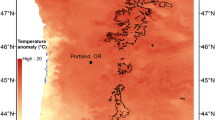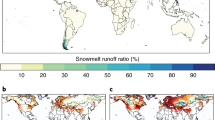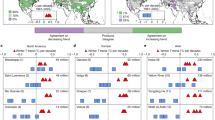Abstract
Mountain snowpack serves as an immense natural water reservoir, and knowledge of snow conditions helps predict seasonal water availability and offers critical early warning of hydrologic drought. This paradigm faces an impending challenge given consensus that a smaller fraction of future precipitation will fall as snow. Here, we apply downscaled hydrologic simulations from 28 climate model projections to show that by mid-century (2036–2065), 69% of historically snowmelt-dominated areas of the western United States see a decline in the ability of snow to predict seasonal drought, increasing to 83% by late century (2070–2099). Reduced predictability arises when peak snowpack approaches zero or because of decreased warm-season runoff efficiency. Changes in drought prediction skill show significant (P < 0.01) elevation dependence, with lower-elevation coastal areas most impacted by warming. Ancillary predictive information can only partially mitigate snow-based predictability losses to 65% of areas, underscoring the importance of declining future snowpack.
This is a preview of subscription content, access via your institution
Access options
Access Nature and 54 other Nature Portfolio journals
Get Nature+, our best-value online-access subscription
$29.99 / 30 days
cancel any time
Subscribe to this journal
Receive 12 print issues and online access
$209.00 per year
only $17.42 per issue
Buy this article
- Purchase on Springer Link
- Instant access to full article PDF
Prices may be subject to local taxes which are calculated during checkout





Similar content being viewed by others
Data availability
All data used in this analysis are publicly available. Snowpack observations were obtained from the NRCS Snow Telemetry (SNOTEL) (http://www.wcc.nrcs.usda.gov/snotel/) and the NRCS Snow Course (https://www.wcc.nrcs.usda.gov/snowcourse/snow-course-sites.html) networks in the United States and the British Columbia Automated Snow Station Network (https://catalogue.data.gov.bc.ca/dataset/archive-automated-snow-weather-station-data) for Canadian stations. A total of 992 stations across these networks met the criteria of greater than 20 years of data and a climatological average 1 April SWE of at least 100 mm and at least 25% of water-year-to-date precipitation to ensure that basins are truly snowmelt dominated. Observations of seasonal streamflow volumes were obtained from US Geological Survey gauges (http://waterdata.usgs.gov/nwis/). We excluded any basins with known regulation, where streamflow is altered by human activity upstream such as irrigation diversions and reservoir releases, on the basis of information provided by both GAGES-II54 and HCDN55 networks. The hydrologically downscaled CMIP5 data used in this study are publicly available: https://gdo-dcp.ucllnl.org/downscaled_cmip_projections/dcpInterface.html.
Code availability
Model codes used to implement the statistical model and to calculate and evaluate changes in ETS are provided at https://doi.org/10.5281/zenodo.3630827.
References
Barnett, T. P., Adam, J. C. & Lettenmaier, D. P. Potential impacts of a warming climate on water availability in snow-dominated regions. Nature 438, 303–309 (2005).
Simpkins, G. Snow-related water woes. Nat. Clim. Change 8, 945 (2018).
Viviroli, D., Dürr, H. H., Messerli, B., Meybeck, M. & Weingartner, R. Mountains of the world, water towers for humanity: typology, mapping, and global significance. Water Resour. Res. 43, W07447 (2007).
Koster, R. D., Mahanama, S. P., Livneh, B., Lettenmaier, D. P. & Reichle, R. H. Skill in streamflow forecasts derived from large-scale estimates of soil moisture and snow. Nat. Geosci. 3, 613–616 (2010).
Wood, A. W. et al. Quantifying streamflow forecast skill elasticity to initial condition and climate prediction skill. J. Hydrometeorol. 17, 651–668 (2016).
Pagano, T. C. Hydrology: soils, snow and streamflow. Nat. Geosci. 3, 591–592 (2010).
Gelfan, A. N. & Motovilov, Y. G. Long-term hydrological forecasting in cold regions: retrospect, current status and prospect. Geogr. Compass 3, 1841–1864 (2009).
O’Gorman, P. A. Contrasting responses of mean and extreme snowfall to climate change. Nature 512, 416–418 (2014).
Pierce, D. W. & Cayan, D. R. The uneven response of different snow measures to human-induced climate warming. J. Clim. 26, 4148–4167 (2012).
Ashfaq, M. et al. Near‐term acceleration of hydroclimatic change in the western U.S. J. Geophys. Res. Atmos. 118, 10676–10693 (2013).
Klos, P. Z., Link, T. E. & Abatzoglou, J. T. Extent of the rain–snow transition zone in the western U.S. under historic and projected climate. Geophys. Res. Lett. 41, 4560–4568 (2014).
Lute, A. C., Abatzoglou, J. T. & Hegewisch, K. C. Projected changes in snowfall extremes and interannual variability of snowfall in the western United States. Water Resour. Res. 51, 960–972 (2015).
Pagano, T., Garen, D. & Sorooshian, S. Evaluation of official western US seasonal water supply outlooks, 1922–2002. J. Hydrometeorol. 5, 896–909 (2004).
van Dijk, A. I. J. M., Peña-Arancibia, J. L., Wood, E. F., Sheffield, J. & Beck, H. E. Global analysis of seasonal streamflow predictability using an ensemble prediction system and observations from 6192 small catchments worldwide. Water Resour. Res. 49, 2729–2746 (2013).
Georgakakos, A. P., Yao, H., Mullusky, M. G. & Georgakakos, K. P. Impacts of climate variability on the operational forecast and management of the Upper Des Moines River Basin. Water Resour. Res. 34, 799–821 (1998).
He, M., Russo, M. & Anderson, M. Predictability of seasonal streamflow in a changing climate in the Sierra Nevada. Climate 4, 57 (2016).
Li, D., Lettenmaier, D. P., Margulis, S. A. & Andreadis, K. The value of accurate high-resolution and spatially continuous snow information to streamflow forecasts. J. Hydrometeorol. 20, 731–749 (2019).
Garen, D. C. Improved techniques in regression‐based streamflow volume forecasting. J. Water Resour. Plan. Manag. 118, 654–670 (1992).
McLaugnlin, W. Problems of the division of irrigation in forecasting water‐supplies. Eos Trans. Am. Geophys. Union 21, 131–134 (1940).
Schermerhorn & Barton, M. A Method for integrating snow survey and precipitation data. In Proc. Western Snow Conference 27–32 (1968).
Stedinger, J. R., Grygier, J. & Yin, H. Seasonal Streamflow Forecasts Based upon Regression (ASCE, 1989).
Zuzel, J. F. & Cox, L. M. A review of operational water supply forecasting techniques in areas of seasonal snowcover. In Proc. 46th Annual Western Snow Conference 18–20 (1978).
Lettenmaier, D. P. & Waddle, T. J. Forecasting Seasonal Snowmelt Runoff: A Summary of Experience with Two Models Applied to Three Cascade Mountain, Washington Drainages Technical Report No. 59 (Office of Water Research and Technology, 1978).
Day, G. N. Extended streamflow forecasting using NWSRFS. J. Water Resour. Plan. Manag. 111, 157–170 (1985).
Wood, A. W. & Lettenmaier, D. P. A test bed for new seasonal hydrologic forecasting approaches in the western United States. Bull. Am. Meteorol. Soc. 87, 1699–1712 (2006).
Mahanama, S., Livneh, B., Koster, R., Lettenmaier, D. & Reichle, R. Soil moisture, snow, and seasonal streamflow forecasts in the United States. J. Hydrometeorol. 13, 189–203 (2012).
Shukla, S. & Lettenmaier, D. P. Seasonal hydrologic prediction in the United States: understanding the role of initial hydrologic conditions and seasonal climate forecast skill. Hydrol. Earth Syst. Sci. 15, 3529–3538 (2011).
Pappenberger, F., Thielen, J. & Del Medico, M. The impact of weather forecast improvements on large scale hydrology: analysing a decade of forecasts of the European Flood Alert System. Hydrol. Process. 25, 1091–1113 (2011).
Hamlet, A. F. & Lettenmaier, D. P. Effects of 20th century warming and climate variability on flood risk in the western U.S. Water Resour. Res. 43, W06427 (2007).
Hartmann, H. C., Pagano, T. C., Sorooshian, S. & Bales, R. Confidence builders. Bull. Am. Meteorol. Soc. 83, 683–698 (2002).
Cuo, L., Pagano, T. C. & Wang, Q. J. A review of quantitative precipitation forecasts and their use in short- to medium-range streamflow forecasting. J. Hydrometeorol. 12, 713–728 (2011).
Garen, D. C. & Pagano, T. C. Statistical Techniques Used in the VIPER Water Supply Forecasting Software Technical Note 210-2 (NRCS, 2010).
Bierkens, M. F. P. & van Beek, L. P. H. Seasonal predictability of European discharge: NAO and hydrological response time. J. Hydrometeorol. 10, 953–968 (2009).
Page, R. & Dilling, L. The critical role of communities of practice and peer learning in scaling hydro-climatic information adoption. Weather Clim. Soc. 11, 851–862 (2019).
Li, D., Wrzesien, M. L., Durand, M., Adam, J. & Lettenmaier, D. P. How much runoff originates as snow in the western United States, and how will that change in the future? Geophys. Res. Lett. 44, 6163–6172 (2017).
Musselman, K. N., Clark, M. P., Liu, C., Ikeda, K. & Rasmussen, R. Slower snowmelt in a warmer world. Nat. Clim. Change 7, 214–219 (2017).
Downscaled CMIP3 and CMIP5 Climate and Hydrology Projections: Release of Hydrology Projections, Comparison with Preceding Information, and Summary of User Needs (Bureau of Reclamation, 2014).
Lott, N. & Ross, T. Tracking and Evaluating US Billion Dollar Weather Disasters, 1980-2005 (NOAA, 2006).
Prudhomme, C. et al. Hydrological droughts in the 21st century, hotspots and uncertainties from a global multimodel ensemble experiment. Proc. Natl Acad. Sci. USA 111, 3262–3267 (2014).
Pagano, T. C., Garen, D. C., Perkins, T. R. & Pasteris, P. A. Daily updating of operational statistical seasonal water supply forecasts for the western US. J. Am. Water Resour. Assoc. 45, 767–778 (2009).
Jennings, K. S., Winchell, T. S., Livneh, B. & Molotch, N. P. Spatial variation of the rain–snow temperature threshold across the Northern Hemisphere. Nat. Commun. 9, 1148 (2018).
Berghuijs, W. R., Woods, R. A. & Hrachowitz, M. A precipitation shift from snow towards rain leads to a decrease in streamflow. Nat. Clim. Change 4, 583–586 (2014).
Barnhart, T. B. et al. Snowmelt rate dictates streamflow. Geophys. Res. Lett. 43, 8006–8016 (2016).
Cherry, J., Cullen, H., Visbeck, M., Small, A. & Uvo, C. Impacts of the North Atlantic Oscillation on Scandinavian hydropower production and energy markets. Water Resour. Manag. 19, 673–691 (2005).
Sankarasubramanian, A. & Lall, U. Flood quantiles in a changing climate: seasonal forecasts and causal relations. Water Resour. Res. 39, 1134 (2003).
Werner, K., Brandon, D., Clark, M. & Gangopadhyay, S. Climate index weighting schemes for NWS ESP-based seasonal volume forecasts. J. Hydrometeorol. 5, 1076–1090 (2004).
McGuire, M., Wood, A. W., Hamlet, A. F. & Lettenmaier, D. P. Use of satellite data for streamflow and reservoir storage forecasts in the Snake River Basin. J. Water Resour. Plan. Manag. 132, 97–110 (2006).
Tang, Q. & Lettenmaier, D. P. Use of satellite snow-cover data for streamflow prediction in the Feather River Basin, California. Int. J. Remote Sens. 31, 3745–3762 (2010).
Minder, J. R., Letcher, T. W. & Liu, C. The character and causes of elevation-dependent warming in high-resolution simulations of Rocky Mountain climate change. J. Clim. 31, 2093–2113 (2017).
Group, M. R. I. E. W. et al. Elevation-dependent warming in mountain regions of the world. Nat. Clim. Change 5, 424–430 (2015).
Moradkhani, H. & Meier, M. Long-lead water supply forecast using large-scale climate predictors and independent component analysis. J. Hydrol. Eng. 15, 744–762 (2010).
Perkins, T. R., Pagano, T. C. & Garen, D. C. Innovative operational seasonal water supply forecasting technologies. J. Soil Water Conserv. 64, 15A–17A (2009).
Golub, G. H. & Reinsch, C. Singular value decomposition and least squares solutions. Numer. Math. 14, 403–420 (1970).
Falcone, J. A. GAGES-II: Geospatial Attributes of Gages for Evaluating Streamflow (USGS, 2011).
Lins, H. F. USGS Hydro-Climatic Data Network 2009 (HCDN-2009) Fact Sheet 3047 (USGS, 2012).
Harpold, A. A., Sutcliffe, K., Clayton, J., Goodbody, A. & Vazquez, S. Does including soil moisture observations improve operational streamflow forecasts in snow-dominated watersheds? J. Am. Water Resour. Assoc. 53, 179–196 (2017).
Schaefer, J. T. The critical success index as an indicator of warning skill. Weather Forecast. 5, 570–575 (1990).
Gilbert, G. K. Finley’s tornado predictions. Am. Meteorol. J. 1, 166 (1884).
Hogan, R. J., Ferro, C. A. T., Jolliffe, I. T. & Stephenson, D. B. Equitability revisited: why the “equitable threat score” is not equitable. Weather Forecast. 25, 710–726 (2009).
Taylor, K. E. et al. CMIP5 Data Reference Syntax (DRS) and Controlled Vocabularies (PCMDI, 2011).
Liang, X., Lettenmaier, D. P., Wood, E. F. & Burges, S. J. A simple hydrologically based model of land surface water and energy fluxes for general circulation models. J. Geophys. Res. Atmos. 99, 14415–14428 (1994).
Brekke, L., Thrasher, B. L., Maurer, E. P. & Pruitt, T. Downscaled CMIP3 and CMIP5 Climate Projections: Release of Downscaled CMIP5 Climate Projections, Comparison with Preceding Information, and Summary of User Needs (Bureau of Reclamation, 2013).
Hidalgo, H. G., Dettinger, M. D. & Cayan, D. R. Downscaling with Constructed Analogues: Daily Precipitation and Temperature Fields over the United States PIER Final Project Report CEC-500-2007-123 (California Energy Commission, 2008).
Wood, A. W., Leung, L. R., Sridhar, V. & Lettenmaier, D. P. Hydrologic implications of dynamical and statistical approaches to downscaling climate model outputs. Climatic Change 62, 189–216 (2004).
Gutmann, E. D. et al. A comparison of statistical and dynamical downscaling of winter precipitation over complex terrain. J. Clim. 25, 262–281 (2011).
van Vuuren, D. P. et al. The representative concentration pathways: an overview. Climatic Change 109, 5–31 (2011).
Cherkauer, K. A., Bowling, L. C. & Lettenmaier, D. P. Variable infiltration capacity cold land process model updates. Glob. Planet. Change 38, 151–159 (2003).
Maurer, E. P., Wood, A. W., Adam, J. C., Lettenmaier, D. P. & Nijssen, B. A long-term hydrologically based dataset of land surface fluxes and states for the conterminous United States. J. Clim. 15, 3237–3251 (2002).
Huang, S. et al. The asymmetric impact of global warming on US drought types and distributions in a large ensemble of 97 hydro-climatic simulations. Sci. Rep. 7, 5891 (2017).
Chen, F. et al. Modeling seasonal snowpack evolution in the complex terrain and forested Colorado Headwaters region: a model intercomparison study. J. Geophys. Res. Atmos. 119, 13795–13819 (2014).
Feng, X. et al. The impact of snow model complexity at three CLPX sites. J. Hydrometeorol. 9, 1464–1481 (2008).
Mote, P. W. Climate-driven variability and trends in mountain snowpack in western North America. J. Clim. 19, 6209–6220 (2006).
Mote, P. W., Hamlet, A. F., Clark, M. P. & Lettenmaier, D. P. Declining mountain snowpack in western North America. Bull. Am. Meteorol. Soc. 86, 39–50 (2005).
Livneh, B., Deems, J. S., Schneider, D., Barsugli, J. J. & Molotch, N. P. Filling in the gaps: inferring spatially distributed precipitation from gauge observations over complex terrain. Water Resour. Res. 50, 8589–8610 (2014).
Acknowledgements
We acknowledge funding support, NOAA Grant # NA16OAR4310132 Advancing the Use of Drought Early Warning Systems in the Upper Colorado River Basin, NOAA Grant # NA15OAR4310144 The Western Water Assessment: Building Climate Resilience by Design, as well as graphical support from the Cooperative Institute for Research in Environmental Sciences (CIRES) at the University of Colorado Boulder.
Author information
Authors and Affiliations
Contributions
B.L. proposed the overall concept for the study and wrote the paper. B.L. and A.M.B. designed components of the analysis. A.M.B. ran nearly all statistical analyses and generated nearly all graphics. B.L. and A.M.B. contributed to interpretations of the results.
Corresponding author
Ethics declarations
Competing interests
The authors declare no competing interests.
Additional information
Peer review information Nature Climate Change thanks Dongyue Li and the other, anonymous, reviewer(s) for their contribution to the peer review of this work.
Publisher’s note Springer Nature remains neutral with regard to jurisdictional claims in published maps and institutional affiliations.
Extended data
Extended Data Fig. 1 Predictive framework example.
Example (top) of time-varying April 1 SWE ‘predictor’ information (blue line) and target flow (black line) together with the statistical predictive model (red line) during a 30-year calibration. The subsequent 5-year application period shows the model prediction (purple line) from which predictive skill is calculated. The procedure is repeated every 5 years through the end of the 21st century (bottom); historical data are used from the Yampa R.at Maybell, CO.
Supplementary information
Supplementary Information
Description of the validation basins, models and data sources, Supplementary Figs. 1–11 and Supplementary Tables 1–3.
Rights and permissions
About this article
Cite this article
Livneh, B., Badger, A.M. Drought less predictable under declining future snowpack. Nat. Clim. Chang. 10, 452–458 (2020). https://doi.org/10.1038/s41558-020-0754-8
Received:
Accepted:
Published:
Issue Date:
DOI: https://doi.org/10.1038/s41558-020-0754-8
This article is cited by
-
Imprint of urbanization on snow precipitation over the continental USA
Nature Communications (2024)
-
Winter snow deficit was a harbinger of summer 2022 socio-hydrologic drought in the Po Basin, Italy
Communications Earth & Environment (2024)
-
Recent decreases in snow water storage in western North America
Communications Earth & Environment (2023)
-
Diagnosing the ability of reservoir operations to meet hydropower production and fisheries needs under climate change in a western cordillera drainage basin
Climatic Change (2023)
-
Global water resources and the role of groundwater in a resilient water future
Nature Reviews Earth & Environment (2023)



